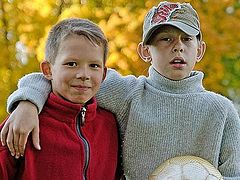To read something pious at the table is a normal thing for a monastery. Everyone sits decorously and eats—quietly, of course. Someone stands at the analogion and reads the Lives of the Saints and the writings of the Church Fathers to the whole refectory…. But to do something like that in the family would be completely impossible—at least in such a large family as mine, with small children. Let’s suppose that the older children would be interested in hearing something at the table. But even so, not for long. And we won’t even talk about the younger ones. If your one-and-a-half-year-old, who puts his potatoes onto his spoon with his hand, tries to bring the spoon up to his mouth, and then cries when they end up on the floor, do you think that there is any way in the world that he is going to let anyone at the table listen to anything? And then: who is going to read? Who is going to be deprived of eating together with the others? Who is going to make him eat up his dinner that has gotten cold, when everybody else is hurrying to get to bed on time in order to go to school or work tomorrow?
All this is unrealistic, from the realm of fantasy. Maybe when the children grow up or when you get a maid you’ll be able to do this? If it’s needed in general, of course.
***
St. John Chrysostom gave his renowned homilies sixteen centuries ago. The sermons of this great ecumenical1 teacher and hierarch are amazingly easy to apply to any era or to any culture. And today we, living in a Russian megalopolis of the twenty-first century can raise our family, our Orthodox family, based on the teaching of this Church Father. Usually we don’t even have to adapt anything—we only have to try to do it, we only have to give it a try.
But sometimes we run across some “little things in life”— even in the words of the Golden-tongued—that are obviously from a bygone culture. On these “unimportant things” the teacher of the whole world constructs important and interesting lessons about this same upbringing of children. Thus, the hierarch speaks over and over again, at various periods of his preaching career, about the educational character of family dinner. This is powerful and beautiful. But it seemed completely inapplicable to my life and to the life of my family.
***
Here is what St. John Chrysostom says about combining meals and education in the family. I will say right away that he is not making any comparisons with any desert-dwellers—we are talking about the most ordinary family.
-
“There is nothing more pleasant than Divine teaching. Listen to what the prophet says about it: How sweet to my throat are Thy words, more than honey and the honeycomb to my mouth (Ps. 118:103).2 Put this honeycomb on the evening table, so as to fill all of it with spiritual gladness.”3
-
In the treatise On the Upbringing of Children, Chrysostom suggests that parents narrate to a child subjects of Holy Scripture “one evening at the meal,”4 then at the following meals “review the lessons already covered.”
-
The saint ends his sermon more than once with similar words: “All this, beloved, let us keep in mind, and when we have returned home, let us offer a double meal—one of food, the other, of what was heard; let the husband pass on what was said, and let the wife learn; let the children also listen, and let the household not be deprived of this instruction…. And so, so that there would be some kind of fruit both for you and for us—to us from being teachers, and to you from listening; let there be offered at your house a spiritual repast together with the bodily one.”5
-
Likewise, “study of spiritual chant” should accompany the meal. Chrysostom calls upon the fathers to “teach their wives and children to sing such songs…especially at the table. Since the devil constructs his crafty designs mostly at times of banqueting with the help of intoxication, overeating, indecent laughter and emotional relaxation, it is especially then, and before the meal and after the meal, that one must protect oneself from him with a fence of psalms, and, having risen from the table, together with wife and children, sing holy songs to God.”6 The whole family takes part in the study of chant and in the very singing itself; under the father’s direction the wife and children sing, and this is an educational act for all the participants.
And so it works out that the time of meals together in the home is a time of education and a time of singing spiritual songs and of studying Holy Scripture.
There is something special about such “instruction at dinner.” It is a lesson inscribed in the lifestyle of a home, built into the life of the house. The father is the teacher at this lesson. He teaches what he himself, in turn, was taught by the Church. What is interesting is that the form of the lesson-meal allows the teaching to be conducted not “from the pulpit,” not “from above,” but as an instruction of conversation, “together,” “side by side.”
***
Absolutely, many families use supper as a time for socializing. They tell how the day went and what happened. Diplomats and businessmen, officials and the mass media do not at all arrange dinners (and lunches and breakfasts) in order to have a tasty bite to eat, but precisely for getting together in order to discuss something, agree on something, become acquainted and come to a mutual understanding in an informal atmosphere.
Supper—especially on holidays—has just that social, sacral, and educational significance in human culture. Banquets in antiquity with their choruses and readings, wedding banquets, and the early Christian agape meals—an endless list of “holy suppers, lunches and dinners,” so varied according to their significance and content can all be continued.
In point of fact, our evening meal—supper—is the only time we eat after the day’s end when the whole family is gathered together at a common table. Only by suppertime is the various school and supplementary work finished; only by suppertime does Dad come home. It is at supper that we are all together and are no longer hurrying anywhere.
***
To sing prayers in chorus, all together before and after meals is easy and simple—it is just an ordinary thing in a church-centered family. But at mealtime…? We’ve sat down at the table—now what? Soul-profiting conversation? How? About what? It should somehow come together all by itself. According to Chrysostom, Dad may, of course, retell what he heard in church. But more often than not we are all there together at the services, and we don’t need anything to be retold.
How then can we join a physical and spiritual meal together, according to the Saint’s precept? The association easily arises to that same monastery reading at the table. We only need to overcome a million obstacles and give it a try anyway.
If we read the Lives of the Saints at the table, something from the conversations of the Church Fathers, contemporary authors, that will definitely be a spiritual trapeza. It’s easy, it’s understandable, you don’t have to think up any special soul-profiting themes. But even if we get around the technical difficulties that we have described, we have to recognize the fact that it may be nice for the parents, but why should the children suffer?
When I was a child, my parents would sometimes arrange a reading at the table like there was at the monastery. And to tell the truth, it quickly became boring. You wanted to say something, but you couldn’t interrupt Papa while he was reading. And you waited and waited and waited, until at last the reading was finished. And what is more, you had finished all your food and you wanted to run to your children’s activities, but you had to listen to the end and continue to sit quietly. Torture!
I often went to monasteries with my parents, and we children often had to be at monastery trapezas. At that time the monasteries had just opened, there weren’t very many people in them, and even little children could sit at the table next to the monks. When I was eight years old I even lived in a skete without my family for three whole days. It was easy to listen to the reading at trapeza then: it seemed like one of the attributes of exclusively adult life. And besides, they didn’t call me to account all the time, demanding silence: the mother to whom I was entrusted was the superior of the skete and sat quite far away from me. So I was able to take pleasure in my meal in peace and at the same time listen to something.
But how to make reading at the table interesting and easy for my children, so that they would be eager for this reading, and not be afraid of it? The main thing, as always, was to begin. And I began to read at the table. I began with the fact that I began to read during the Great Fast. With a newborn baby in my arms I sat at the table with everyone else—the other children and Dad ate, while I read. It wasn’t difficult. The baby wouldn’t let me eat in peace anyway. After the reading I gave the baby to my husband, and I myself ate.
Then we returned to reading at table periodically. For example, on the eve of a feast we needed to tell the older children about the event that was being celebrated, but there wasn’t any time. Supper was the very time when we could tell the children something in our own words or read something to them. Little by little reading at suppertime changed from being a new and strange burden to an ordinary and eagerly-awaited event. And although the organization of such an “educational trapeza” is carried out in test mode in our family, and certainly changes in circumstances will entail new unexpected particulars, nevertheless we can already draw certain conclusions from this experiment.
Don’t read too long
You need to read just a little bit—one or two paragraphs. No matter what the reading is, even the most serious philosophical-theological treatise, the children (at least from five to eleven years old) listen quite attentively when I first begin to read. And here, the most important thing is to stop in time. If it’s a sermon—by the same St. John Chrysostom—it’s entirely sufficient for them to hear one complete thought. If it’s a narrative—the Patericon or an excerpt from the Lives of the Saints—it’s good to stop at the most interesting part, so that the children would ask you to continue reading. You can finish reading, for example, before they go to bed. Or tell the ending in your own words. In such a case not only will reading at the table turn out to be easy and interesting, but the children will perceive it as a gift. You can even read till the end, but in this case it should be a very short Life—two pages maximum.
This “short reading” has to be started just as soon as everyone has sat down at the table—while the plates and the glasses are full, while everyone is chewing and consequently, keeping quiet; before anyone needs “a little more juice” or “seconds,” before you find out that someone has pushed or someone has dropped their fork. Even a one-year-old who is just learning to eat is absorbed enough in picking at the food on his plate during the first few minutes, and doesn’t need any special attention. It’s better to finish by the time everyone’s hunger has been satisfied and the first glasses have been drained. Exactly how much time you can spend and how much you can read is determined by experience; it depends on the age of the children and how they behave themselves.
It has to be interesting
First and foremost, the reading has to be interesting to me, myself. If it’s boring to me, then it is a burdensome duty that I for some ideological consideration have foisted on myself and my children, and the children will feel this without fail. They are very sensitive to such issues. Of course, on that particular day I may not necessarily have an overwhelming desire to read Theophan the Recluse. But if I love his works—for example, his letters—then this love will “come through” without fail while I read. It will come through and wake me, myself, from the bustle of the past day, from tiredness, from depression or, conversely, from too much excitement…. If I myself am not happy reading this selection, then gradually I will be sure to find a reason and excuse to stop such an experiment, and such “readings at supper” will quickly stop.
What exactly should I read?
The choice of literature for reading at the table should be determined by our goal: why do we read in general? In order to get some benefit “for the soul” at the same time that we eat. To direct our thoughts in a certain way. To learn something. To find out something new relating to the spiritual life. We read what suits us, what is close to us, just what I and my family need here and now.
We can use something already prepared. Let’s say that we like St. Ambrose of Optina’s calendar with “thoughts for every day.” In this case we can read these very thoughts at the table. It’s convenient—you don’t have select anything special: the calendar with a little bookmark is sitting in the kitchen. Or it could be the life of the saint of the day. For a feastday, we can read a special reading just for that day (for example, from the selection that is on the web site OrthoChristian.com.: the holy fathers, Metr. Anthony of Sourozh, Fr. John Krestiankin), or C.S. Lewis—there is a large choice.
If we are going to read the Old Testament at supper every day or the History of the Church—each day a small topic—this will be a part of a real religious education for the whole family. Gradually, day after day, month after month we will “take a course” in Church History or some other chosen “subject.”
No one is forcing any framework onto us—today we may read something that was planned, while tomorrow we might read the children some thought that we came across in a book or on the Internet. This will be a reason to share with the children and my spouse something valuable that I myself learned today—a reason to discuss something important.
Reading at the table as a pedagogical method
A discussion of the reading may actually be the most important part of “reading at supper.” If we chose some reading especially for a feast day supper, it means that some thought seemed important to us, interesting and close. We can and should state it here and now at the table. The children can listen to all of it quietly, or can ask questions, or can even tell something connected with what was read, or even without any connection with it.
The reading at the table is the theme set for conversation at the table—almost like at the ancient Greek feasts, where a theme was chosen for conversation at the banquet. The reading determines the general tone of the conversation. After reading St. Nikolai Velimirovich or The Spiritual Meadow, it is not likely that inappropriate anecdotes or a discussion of someone else’s dirty laundry will follow—this supper is not likely to end in gluttony or drunkenness. At the very least it will be harder to approach such a finale.
A discussion of something read from Church History, for example, likewise will prove to be a “review of material already covered”; it will fix in the children’s memory what was just received. In this way, the daily family supper becomes a most real lesson, a “spiritual and moral education” or “Foundations of Orthodox Culture” (the exact titles here are not important), because this is life itself, it is an education for all the members of the family, a symposium arranged according to all the canons of the educational process.
Listening to the adults’ conversation is also a method
Children are not always ready to discuss what was read. To drag an “opinion” or “questions” out of them forcefully is not only difficult but also not right. A child heard something, and maybe right now it went “in one ear and out the other.” And only later will a chain of associations return him to the theme that was being discussed. It’s possible that a thought will ripen for a long time, and the child will ask his question only before bedtime. And it’s possible that there won’t be any questions at all…. It is far easier to discuss what was read with your husband rather than with the children—then it will be easier for the children to follow in suit. But often children do not take part in the parents’ conversation, but simply listen.
What can be more entertaining than to have the opportunity to listen in on the grown-ups’ conversation without interference! When I was a child, my parents would often have guests over—very, very interesting people. Priests, artists—the most varied sorts of people were guests at our house. The adults liked to discuss their grown-up business without the little children. But here at the table there was no place for them to get away from us. The adults talked and we listened, sopping up every word, remembering much of it for our whole lives. The topics may have been entirely not for children—politics, theology, philosophy or art. The supper table was the one legal means for us to listen in on such conversations. If the parents sat a child down in front of them and began to say the same things, the child would be bored. But here were some topics that were not at all addressed to children—it made them perk up their ears, their curiosity reached its peak. Now I observe my children: sometimes it is so difficult to draw their attention to an ordinary “moral” topic! But just let me begin to discuss the same topic with my husband, and there are the older children with bated breath…listening to “the grown-ups’ conversation.” And if the children do as they are told and go out when we don’t let them listen to our conversation, then their heightened interest in further adult conversations doesn’t hurt. It’s normal, healthy that we are interesting and important to our children.
This feature (the children’s heightened interest in conversations that aren’t addressed to them) can easily be used at family suppertime. I often read something, for example, from Church History, and after the reading my husband will comment, specify and explain—to me, not to the children. But the children are listening. If the younger children start to make noise, the older children will stop them, themselves: “Quiet! I can’t hear what Papa is saying!” Sometimes I ask my husband a question on purpose after the reading, so that his explanation would draw the children’s attention to a particular aspect of what we just heard, in order to review something important. This has become a tradition, and consequently, it no longer needs any special effort.
But when can the reader eat?
This question seriously bothered me when I had only just started at some time to try reading at the table. But in actual practice everything turned out to be simple. If it was a feast day supper, I try to read something so short that my portion doesn’t even have time to get cold, and afterwards, when we are discussing what was read, I eat my dinner in peace along with everyone else.
Our daily evening meals together are devoted to “longer” readings. And this is even more convenient for me. When I was beginning to gradually wean my youngest baby, it was time for me to get my health in order, including my weight, so as to be ready for my next pregnancy, and in general to be healthy and beautiful. Mama, you know—all the more if she has many children—is simply obliged to look after herself, and her health for the sake of her husband and the children that the Lord has already given and perhaps will yet give. But pregnancy with excess weight means a difficult labor and an additional load on her back, heart, feet—and it especially means varicose veins.
For a pregnant and nursing mom with many children, it isn’t so very hard to keep herself in shape if, of course, she doesn’t have any particular illnesses. And one of the simplest and most effective ways of getting into shape is—aside from an active lifestyle—to simply skip supper. All the more so, as I “sit at home with the children” and more than adequately nourish myself in the course of the day. But my “working from morning till evening” husband and all the children, of course, should get a delicious and satisfying supper. For this reason it’s difficult to keep from eating—that’s why I try to do something special at suppertime.
Now I read during mealtime, and how easy it is not to have supper! When I finish the reading, practically all the plates are clean, all the food that entices me is either eaten up, or has gotten cold and doesn’t tempt me so much. Reading at the table in this case is a real find for such a mom who is trying to lose weight, because supper is the time when the whole family is gathered together, and once I don’t have supper myself, what is left? To do housework? That isn’t right to miss the chance to sit a while with everyone at the table. Thus, reading at the table has resolved all my problems. True, for the moment I still couldn’t imagine what I would do if God gave another infant, and for night feeding I had to eat supper without fail. Then, I suppose, as at our first readings during the Great Fast, I would read with the infant in my arms. I am sure that everything would fall into place of its own accord, as it has fallen into place now.
You can read every day at suppertime. Or you can read only once a week—on Saturdays, for example, or at Sunday dinner, when the family returns home after Liturgy. This is not so important; the most important thing is to arrange it so that at least once a week trapeza joins the whole family together at the same table, so that it would be joyful—to be together, to be next to each other, so that this common table would unite people not only by good food, but also by socializing with each other. And so that this socializiing would bring “spiritual gladness” and benefit to all whos sit at our table




